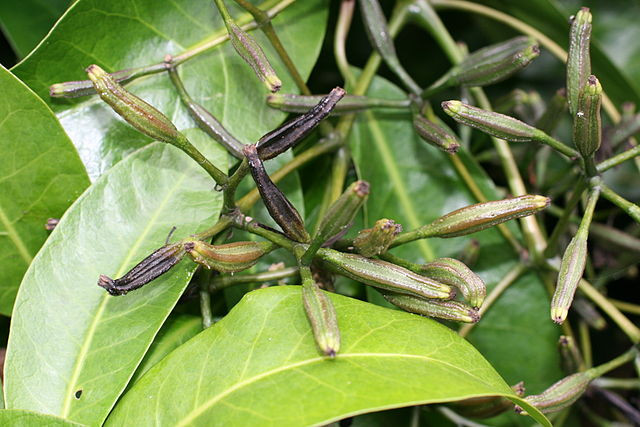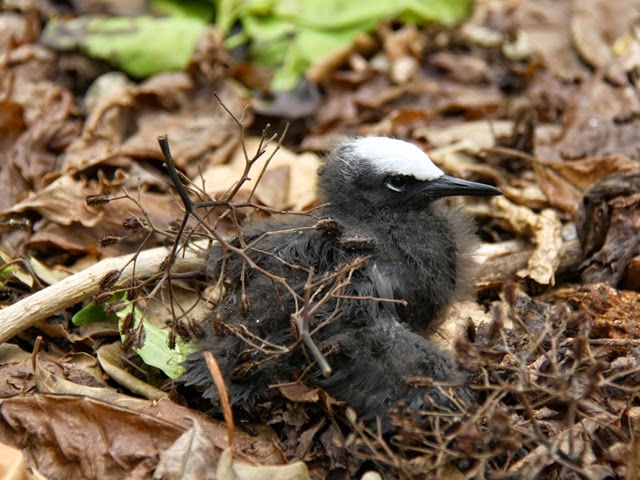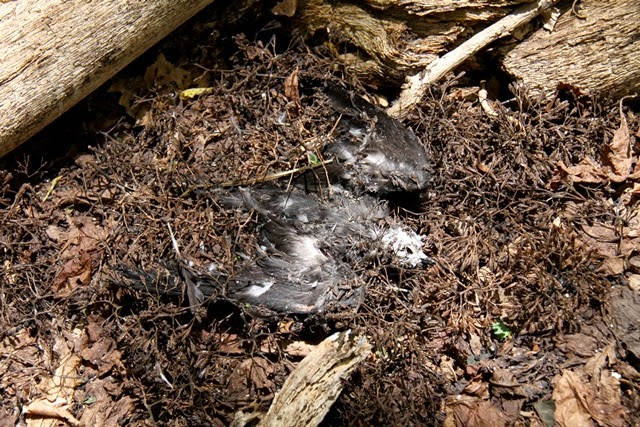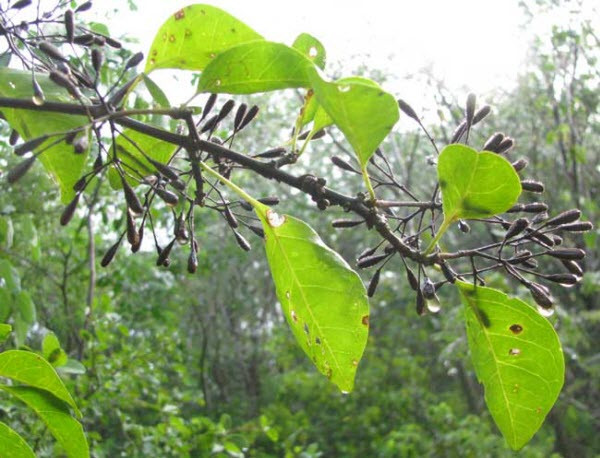The mysterious dead tree makes birds die
Many people have heard of creepy carnivorous plants that trap insects as food. But there is one more scary tree, any bird that accidentally encounters its fruit does not escape death.
Anyone who comes close to this exotic plant has a chill because underneath this tree are the dead corpses of decayed birds.

Fruit of Pisonia tree.(Internet photo.)
The scary plant, called Pisonia, or the bird-catcher tree, lives in the tropical waters of India and the Pacific. They use a special method to help the seed not go too far from their area, but it turns out their effects become scary traps for seabirds.
The fruit of the Pisonia tree is about 7-14mm long, has spines and especially produces an extremely sticky substance. If any bad bird accidentally gets into it, it will be like sticking to a trap that can't fly or move.
 An ill-fated bird caught in the fruit of the Pisonia tree.(Internet photo.)
An ill-fated bird caught in the fruit of the Pisonia tree.(Internet photo.)
They can only "powerless" to lie there as "meals" for other carnivores or to die. At that time, their bodies decompose to form nutrient-rich organic matter for the seeds of the Pisonia plant to germinate and grow.
However, the real reason for the mechanism of seed dispersal of this exotic plant is still a mystery to ecologists.
In the 1990s, Alan Burger from Victorya University, Canada went to Cousin Island (Seychelles) to witness firsthand the deadly reputation of the Pisonia tree.
 The bodies of the birds will decompose under the tree.(Photo: Internet.)
The bodies of the birds will decompose under the tree.(Photo: Internet.)
He was amazed to see so many decaying corpses of birds under the tree. Their wings and feathers were all stained by the glue that the pisonia fruit produced.
In about 10 months from 1999 to 2000, Alan Burger made many researches and experiments to find the real answer to the goal of " trapping birds " of Pisonia trees.
He realized that when they removed the seeds of Pisonia plants under seawater, within five days they died of embryos and could not germinate. But thanks to the dead corpses of birds under the tree, the seeds germinate and grow better, while making the soil below rich in nutrients.

Internet photos.
Since then, he has concluded, it is very likely that his seed should not be brought to places where conditions cannot be germinated, this plant has released a sticky substance to neutralize its ability. fly of birds, help the seed not be dispersed too far.
- The mystery of the "ghost tree" poisoning itself in exchange for nutrients
- Not only people but even animals do not dare to array to the unique tree species on this planet
You should read it
- 12 types of ornamental plants clean the indoor air
- 12 kinds of ornamental plants bring fortune to the house on Tet holiday
- 11 species of lethal poisonous plants that we should avoid
- Top 4 best selling hot and cold water plants today
- 8 types of plants that resist ultra-good electromagnetic radiation for those who regularly use computers
- New plant species discovered in China
- 3 'miraculous' ingredients turn your tree back to life
- How to Protect Plants
May be interested
- Visit the tree office that Microsoft makes employees, chatting, working or sunbathing
 in order to create a better working environment for employees, microsoft has built tree houses right near the offices of top microsoft ceos like ceo satya nadella. and any employee can use them to meet, chat or work together.
in order to create a better working environment for employees, microsoft has built tree houses right near the offices of top microsoft ceos like ceo satya nadella. and any employee can use them to meet, chat or work together. - Not the Bermuda triangle, this is the most horrible 'black cemetery' in the world
 to this day, the mystery of the horrific disappearances in this dead land has yet to be deciphered and many people are frightened.
to this day, the mystery of the horrific disappearances in this dead land has yet to be deciphered and many people are frightened. - Trees shy and mysterious have no explanation for the strange behavior of plants
 if you have the opportunity to walk into the forest, take a moment to look up at the tall trees, maybe you'll be surprised at what you see.
if you have the opportunity to walk into the forest, take a moment to look up at the tall trees, maybe you'll be surprised at what you see. - Decipher the mysterious 'dead zone' inside of the tornado
 the central area of the cyclone is the center of the storm, an area with almost calm and quiet weather conditions, but with deadly dangers.
the central area of the cyclone is the center of the storm, an area with almost calm and quiet weather conditions, but with deadly dangers. - Spanning Tree in data structure and algorithm
 a spanning tree is a subset of grahp g that has all vertices enclosed by the minimum number of edges. therefore, a spanning tree will not form a cycle and it cannot be interrupted in the middle.
a spanning tree is a subset of grahp g that has all vertices enclosed by the minimum number of edges. therefore, a spanning tree will not form a cycle and it cannot be interrupted in the middle. - The mystery of how people and birds communicate
 workers who collect honey often find and break into hives with birds.
workers who collect honey often find and break into hives with birds. - How The Walking Dead compared horrible Covid-19 to the zombie apocalypse in the movie
 the fact that everyone isolating at home to avoid covid-19 makes the streets suddenly become unusually deserted, and why the walking dead of course is no stranger to this context.
the fact that everyone isolating at home to avoid covid-19 makes the streets suddenly become unusually deserted, and why the walking dead of course is no stranger to this context. - Angry Birds Epic has a 2-player 'antagonistic' version
 after a while launching the version of angry birds epic, rovio has just released a new update with support for fighting mode at the same time 2 people are parallel to each other.
after a while launching the version of angry birds epic, rovio has just released a new update with support for fighting mode at the same time 2 people are parallel to each other. - The oldest tree in the world 'old' 9550 years old
 plants are one of the most enduring species in the world, from the century to the other and even from the millennium to the other millennium. so which tree is the oldest 9.550-year-old tree in the world since the ice age?
plants are one of the most enduring species in the world, from the century to the other and even from the millennium to the other millennium. so which tree is the oldest 9.550-year-old tree in the world since the ice age? - Rovio launched the Angry Birds Transformers game trailer
 about a month ago, rovio revealed that they are collaborating with hasbro to produce a special version of angry bird transformers called angry birds transformers, eating the hit transformers series.
about a month ago, rovio revealed that they are collaborating with hasbro to produce a special version of angry bird transformers called angry birds transformers, eating the hit transformers series.










 Two new species of parasitic plants discovered in Okinawa
Two new species of parasitic plants discovered in Okinawa It turned out that the octopus gave up its ability to evolve to become smarter
It turned out that the octopus gave up its ability to evolve to become smarter Humans are not the only species with fingerprints
Humans are not the only species with fingerprints Mysterious lake 'death' in Africa robbed more than 1700 lives in one night
Mysterious lake 'death' in Africa robbed more than 1700 lives in one night 20 animals are so strange that you don't believe they exist on Earth (part 2)
20 animals are so strange that you don't believe they exist on Earth (part 2) The list of 'horror' mosquitoes does not bother to suck human blood
The list of 'horror' mosquitoes does not bother to suck human blood